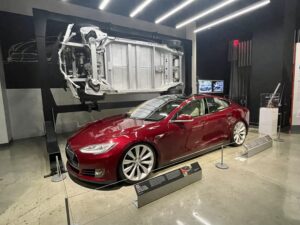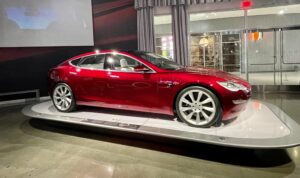The History of the Tesla Model S 
Considered Tesla’s flagship model, the Tesla Model S is described as the highest-performing sedan ever built. Originally codenamed White Star, it was announced in June 2008, and its prototype was displayed in March 2009. Production was announced in May 2010 at the Tesla Factory in Fremont, California. The first Model S sedans were produced a year later. The official release of the first ten cars took place in June 2012. In 2013, the Tesla Model S received several prestigious awards. This includes the World Green Car of the Year, Motor Trend Car of the Year, and Automobile Magazine’s Car of the Year. It was also recognized as one of Time Magazine’s Best 25 Inventions. Consumer Reports did not initially recommend the model due to reliability concerns but later changed their decision.
In 2015, Car and Driver named it the Car of the Century. In September 2014, Tesla released the autopilot feature. This came equipped with cameras, forward-looking radar, and location sensors for a 360-degree view. A month later, Tesla introduced the “Dual Drive” all-wheel drive (AWD) versions of the Model S 60, 85, and P85 models. A year later, Tesla celebrated the total distance traveled by Model S cars. A space surpassing 1 billion kilometers, making it the first all-electric car to achieve this milestone. In terms of sales, the Tesla S exceeded 100,000 units in 2015 and 150,000 in 2016. Unlike other electric cars that replace a combustion engine with an electric motor, the Tesla S was designed from the ground up with an electric powertrain in mind.
Design Inspiration
Led by a former Mazda North American Operations worker, the design team incorporated unique features such as a front trunk, or “frunk,” a rear compartment, and a larger crumple zone. The different versions of the Tesla Model S vary based on energy capacity, motor size, and equipment. With a length of 3.4m3, the Environmental Protection Agency classifies it as a “Large Car” or “Luxury Sedan.” In the United States, it is a full-size luxury car; in Germany, it is an S-segment sports car or Oberklasse (F-segment). The powertrain of the Tesla S has undergone continuous upgrades, resulting in improved durability, efficiency, and power. The vehicle’s power distribution is electronically controlled. The introduction of the tri-motor Plaid version solidified its position as the world’s fastest-accelerating production car.
 Battery Capacity
Battery Capacity
Two years after production began, the base model had a United States Environmental Protection Agency (EPA) range of 335 km, while the longer-range model had a range of 426 km. The battery in the original design had an energy density of over 250 Wh/kg, accounting for a significant portion of the vehicle’s total cost. Tesla offers a 60 kWh battery that provides 200,000 km of travel and an 85 kWh battery with unlimited distance. Over the years, battery capacity has increased, ranging from 60 kWh to 100 kWh. Tesla now emphasizes the vehicle’s range rather than the battery capacity. The battery pack is the heaviest part of the Tesla Model S, positioned on the floor between the axles to achieve a lower center of gravity and improve safety. Tesla has built numerous 480-volt charging stations known as Tesla Superchargers to address the need for periodic charging on long-distance trips.
The Model S has a range that is more than double that of the Nissan Leaf and features superior motor efficiency and rolling resistance. Most Tesla S vehicles come equipped with height-adjustable and self-leveling air suspension, allowing the driver to control the shock absorbers. The suspension system automatically adjusts to different road conditions, improving comfort and handling. The entire roof of the Tesla Model S is high-strength glass. Additionally, it provides a panoramic view. This change made the panoramic sunroof an unavailable option. Safety In 2015, the U.S. National Highway Traffic Safety Administration (NHTSA) and Euro NCAP awarded the Tesla S a 5-star safety rating, an achievement shared by only two other cars since 2011.
Safety Speculation
However, two years later, the Insurance Institute for Highway Safety (IIHS) identified flaws in the Tesla Model S safety belts. Thus, the seat belts allowed excessive forward movement for the driver’s torso. It causes a complex impact of the driver’s head on the steering wheel despite the presence of an airbag. The Model S headlights also received the worst possible rating, leading to a 6.4% stock value loss for Tesla. In October 2013, a Tesla Model S caught fire shortly after hitting metal debris on Washington State Route 167. The driver exited the vehicle without injury. Also, the built-in vents redirected the flames away from the passenger compartment, preventing further damage.
The National Highway Traffic Safety Administration (NHTSA) stated that no evidence suggests a vehicle safety defect caused the fire. An evaluation of undercarriage strikes on the 2013 Model S was examined and closed in March 2014. This was after Tesla implemented new technologies to control underbody strikes and minimize fire risks. In conclusion, the Tesla Model S has achieved remarkable performance, range, and safety milestones.
